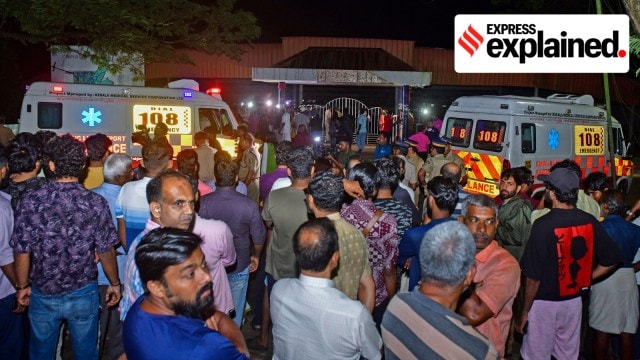Here is a look at how the mishap unfolded at the campus of Kerala’s premier higher education institution.

What was the event
The school of engineering at CUSAT was holding its three-day annual technical festival, Dhishna. November 25 was the second day of the event, a platform to showcase and hone technical talents and skills of students. The event was supposed to be attended by 2,000 students, including those from other colleges.
On Saturday, the day’s programmes were over around 5.30 pm. Students moved to the university’s open air auditorium, where playback singer Nikhita Gandhi was scheduled to perform after 7 pm.
Where the stampede happened
The stampede took place at the entrance to the open-air auditorium, which has a capacity to seat 1,500 persons. It has only one gate. From the entrance, one has to take a dozen stairs down to enter the amphitheatre. The facility is ringed with an iron fence. After 6 pm, audiences started entering this area through the single gate. Priority was given to students wearing Dhishna T-shirts, students of the school of engineering, and to the organisers of the festival.
How it all went wrong
As the time for the musical show approached, a crowd started growing outside the entrance gate, including students as well as the general public. People press for the gate to be opened and entry allowed to all. Initial police reports said it was drizzling, which made the crowd more impatient, although most students at the venue have not confirmed the rain.
As the crowd burgeoned, the gate was suddenly opened for all. Students who were standing or walking down the stairs to the open-air auditorium fell in the sudden push from the crowd behind. These steps were steep. The crowd that entered the auditorium stepped on those who had fallen and trampled them to death. The victims sustained multiple injuries, their internal organs badly damaged and even faces disfigured in the unexpected freak stampede.
Story continues below this ad
Initial findings of authorities
The CUSAT prima facie is of the view that the delay in allowing entry for students, coupled with the steep stairs down to the amphitheatre, contributed to the tragedy. When the crowd started growing, volunteers at the gate had to open it for everyone, leading to a surge on the stairs. The programme was organised and managed by students.
Six policemen had been patrolling the area. Kochi city police said neither the CUSAT nor the organising students sought prior permission from the police about the event. As the festival was an in-house campus event, such a permission was not mandatory. But CUSAT VC Dr P G Sankaran said the police had been verbally informed about the event.
What government is planning
Apart from the police probe, the state government has ordered a probe by the secretary to the higher education department. The district administration is also conducting a magisterial probe into the mishap. The government is planning to bring in new norms or revise existing ones with regard to the conduct of events attended by large crowds. In the wake of last month’s blast at a Christian convention in Kochi, all auditoriums have been given instructions on crowd management. However, this did not include events at educational campuses.
History of CUSAT
Story continues below this ad
CUSAT is a premier educational hub in Kerala with 9,000-odd students at the Kochi campus and off-centres. It has no affiliated colleges, but runs several graduate and post‐graduate courses in advanced research in Applied Sciences, Technology, Industry, Commerce, Management and Social Sciences.
The university started in 1938 as a school of Marine Sciences of the Oceanographic Laboratory in the erstwhile Travancore University. In 1971, the Kochi or Ernakulam centre of the University of Kerala was converted into University of Cochin, which was elevated to CUSAT in 1986.








































